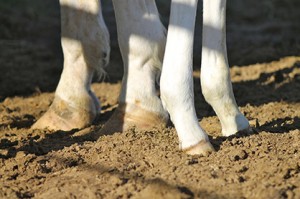Equine Lameness: The Basics
With the Chinese New Year approaching on January the 31st, it is time we recognize the New Year’s Chinese Zodiac: the horse, symbolizing character traits such as intelligence, energy, and strength. While the Chinese Zodiac horse may be strong and full of energy, what happens when yours adopts uncharacteristic behaviors of limited mobility and weakness? Though equine lameness is a problem seen in many horses during their lifetime, there are ways of preventing and treating it to help your horse be as healthy as the Chinese Zodiac horse this year.
Equine lameness has various different causes. “Some of the common causes are due to a traumatic event, a performance induced injury—such as a strained tendon or ligament or pulled muscle—or a wear and tear type injuries causing arthritis or bone spurs in joints termed osteoarthritis,” said Dr. Robin Dabareiner, Associate Professor at the Texas A&M College of Veterinary Medicine & Biomedical Sciences. “There are also some causes of lameness that young horses are born with termed, ‘developmental bone disease,’ where the cartilage and bones do not form correctly. “ Once recognized, it is important to have a lameness evaluated immediately by a veterinarian.
Noticing that your horse is limping or moving irregularly is an obvious way to detect lameness. A horse used for barrel racing, for instance, will, all of a sudden, quit wanting to run the barrel correctly. The next step would be for the owner to seek help from a veterinarian, who will then observe his movement and perform nerve blocks to determine which area of the leg is hurting. “After localizing the source of pain, diagnostic imaging is the next step,” said Dabareiner. “Using radiographs (x-rays), ultrasound, or MRI, we can look at images of the area to see what is causing the pain.”
Treatments for lameness can include anything from rest and anti-inflammatory medications to joint injections with cortisone to surgery. “The treatment depends on what the problem is, and there are usually numerous different treatments for every problem,” said Dabareiner. “Choice of treatment varies with many factors such as what the horse’s job is, owner expectation, severity of the problem, age of the horse, and cost of treatment.”
In order to prevent lameness, you should always be sure that the horse is in the right physical condition to perform the job he is doing. Some strategies for preventing such injuries could include letting horses get to know each other before turning them into a pasture together, or using protective leg gear when riding or competing and avoiding deep or muddy grounds.
Hopefully, the Chinese New Year will bring your horse immense amounts of strength and energy. If Seabiscuit isn’t behaving quite like himself, however, these tips for preventing and treating lameness should get him feeling race-ready in no time at all.
Pet Talk is a service of the College of Veterinary Medicine & Biomedical Sciences, Texas A&M University. Stories can be viewed on the Web at vetmed.tamu.edu/pettalk. Suggestions for future topics may be directed to editor@cvm.tamu.edu











